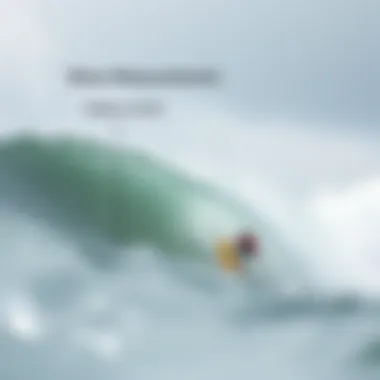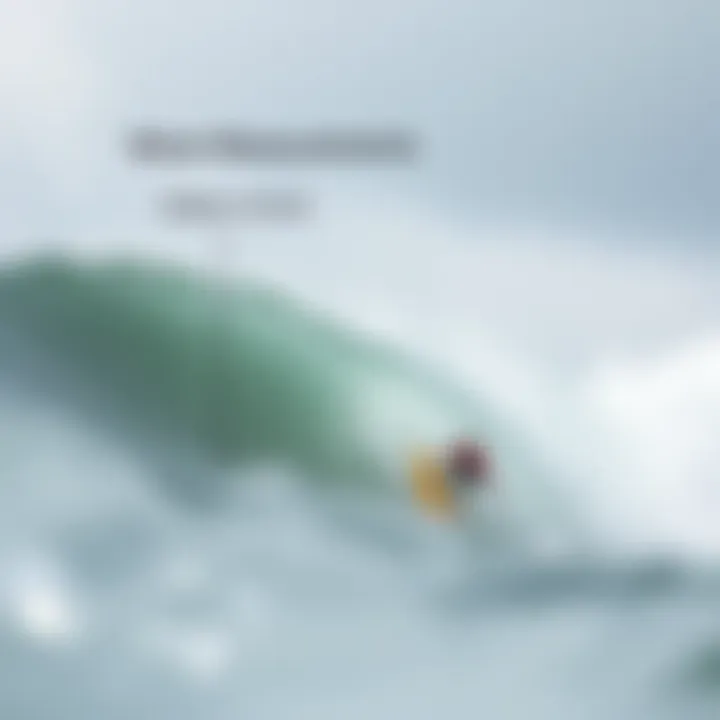Understanding Wave Height: Key Factors for Surfing Success


Intro
The thrill of catching a wave is difficult to describe. For many surfers, it’s not just a hobby; it's a way of life. But before paddling out, understanding the nuances of wave height is crucial. Wave height can dictate whether a swell is rideable or if it might knock you off your board in an instant. The essence of a great surfing experience often hinges on this seemingly simple metric, yet its implications run deep.
Why Wave Height Matters
Wave height informs surfers not only about potential thrill but also about safety. Too high, and they can become daunting, but too low can mean a flat day. Therefore, knowing how to interpret wave height can be the dividing line between an exhilarating ride and an unpleasant tumble. The surfing community relies heavily on this data, making it pivotal for enthusiasts at all levels.
Surfers must be attuned to local conditions. Every beach has its unique characteristics, influenced by factors like wind, tide, and geomorphology. Additionally, technological advancements have transformed how surfers gauge wave height. Through dedicated apps that analyze live conditions, surfers can now make more informed decisions about where and when to hit the surf.
In this article, we will solidify your understanding of wave height, its measurement, and its impact on surfing. We will also dive into the surfing techniques that can help you optimize your ride based on the conditions available. Further, we'll touch upon sustainable practices within the surfing culture and how wave height plays a role in these discussions.
Defining Wave Height
Understanding wave height is essential for both seasoned surfers and those just dipping their toes into the water. Wave height refers to the vertical distance between the trough (the lowest point) and the crest (the highest point) of a wave. This deceptively simple definition is packed with significance, as it informs surfers about the sea conditions they will face. Furthermore, knowing how to gauge wave height can enhance a surfer's safety and performance on the water.
The Importance of Understanding Wave Height
Grasping the nuances of wave height can greatly improve the surfing experience. A surfer equipped with this knowledge can make informed decisions about when to ride the waves, which spots to target, and what equipment is appropriate. This understanding not only affects performance but can also be a matter of safety. For instance, an amateur surfer might find themselves in over their head if they venture into waves that are too high for their skill level.
Additionally, recognizing patterns in wave height can be pivotal when planning surf trips. Different surf breaks react uniquely to varying swell conditions. By being attuned to these changes, surfers can optimize their time on the water and maximize their enjoyment. When wind, currents, and tide cycles align, the result can be perfect wave conditions that every surfer dreams of.
Types of Wave Heights
Wave height is classified into several categories, each serving a different purpose in wave analysis. These classifications help in understanding potential surfing conditions better.
Significant Wave Height
The significant wave height is the average height of the highest one-third of waves. This measurement gives a more reliable indicator of sea conditions, especially in surf forecasting. Instead of just looking at the tallest wave, significant wave height accounts for the average strength of swells encountered. It’s often regarded as the most standard metric because it reflects the wave's impact on surfers more accurately than other measurements. Having an appreciation for significant wave height can guide surfers in choosing a beach and time to surf.
Maximum Wave Height
Maximum wave height refers to the tallest wave observed in a particular period. While this number can be quite impressive, it can also be misleading. Those drawn to surfing often mistake maximum wave height as an indicator of the best conditions; however, this number can stem from abnormal swells or storms, leading to unpredictable and dangerous conditions. Surfers need to remain cautious and understand that while a high maximum wave height can look enticing, it may not represent the typical conditions they should seek out.
Average Wave Height
Average wave height, as the name suggests, is a simple calculation that adds up the heights of all waves in a set and divides that number by the total count of those waves. This data can yield insights into the general surf conditions one might expect on a given day. While it’s less precise in pinpointing potential high risks or excellent swells compared to significant wave height, average wave height is still valuable for surfers to assess overall conditions, allowing a broader perspective on wave behavior.
Understanding these types of wave heights enhances a surfer's ability to navigate the waters effectively and safely, ensuring better surf experiences.
Factors Influencing Wave Height
Understanding wave height is crucial for surf enthusiasts, as it can dictate the quality of surfing conditions. Various factors play a role in the dynamics of wave formation, each one interlinked with others, resulting in the wave patterns observed at surf spots. Knowing these influences can not only enhance a surfer's ability to choose the right time and place but also prepare them for any potentially dangerous situations. Let’s explore these pivotal elements in depth.
Wind Conditions
Wind is one of the primary forces behind wave development. When the wind blows across the surface of the ocean, its energy transfers to the water, creating waves. The strength, direction, and duration of wind can significantly alter wave height.
- Strength: Stronger winds typically produce larger waves, as they impart more energy into the water. Swells resulting from gale-force winds can travel vast distances, maintaining their energy level.
- Direction: The angle at which the wind hits the water matters. Onshore winds, blowing from the sea toward the land, can create choppy conditions, while offshore winds, blowing toward the ocean, often result in cleaner, more well-defined waves.
- Duration: If a wind blows steadily over a longer period, it generates larger swells as it continues to transfer energy to the waves. This is why surfers often await consistent wind patterns.
Tides and Currents
Tides can drastically influence the behavior of waves experienced at a particular surf spot.
- High Tides vs. Low Tides: During high tide, waves may break differently compared to low tide, affecting their height and shape. Some locations work better with rising tides while others may favor lower tides, creating unique conditions ideal for different types of surfers.
- Currents: Tidal currents can also affect the size and shape of waves. An incoming tide may amplify wave height by funneling swells into a narrower area, while an outgoing tide could mellow those same waves.
Geographic Features of the Coastline


The shape and structure of a coastline play a significant role in wave behavior. Features like reefs, points, bays, and beaches can either enhance or diminish wave heights.
- Sandbars: These structures can create more powerful waves. As waves approach shallow water over a sandbar, they can steepen and increase in height, offering thrilling ride for surfers.
- Reefs: Coral reefs can serve as natural breakwaters, channeling waves and often creating more hollow and steep waves, sought after by experienced surfers.
- Jetties and Entrances: Man-made structures can also change local wave patterns, sometimes creating inconsistent waves that require careful observation beforehand.
Storm Activity
Storms can be a mixed bag for surfers. While they produce substantial swells, the associated risks are significant.
- Tropical Storms and Hurricanes: These weather phenomena generate enormous waves that can reach heights difficult to manage. The energy from such events can create formidable surf, but they can also bring dangerous conditions, including strong currents and debris in the water.
- Cold Fronts: Even winter storms can create powerful swells, albeit usually with colder water temperatures, which can impact a surfer’s comfort and equipment needs.
"Understanding the environmental and meteorological factors behind wave formation is essential for any surfer aiming to improve their experience on the water."
This intricate dance of wind, tide, currents, and storms indicates that surfers must continuously evaluate conditions to gauge wave quality. Much like chess players anticipating their opponent's moves, surfers must foresee how these factors play out, ensuring not only a perfect ride but also their safety in the lineup.
How Wave Height is Measured
Understanding how wave height is measured is paramount for surfers looking to catch the perfect wave. Accurate measurement not only helps in planning surf sessions but also ensures safety while navigating the unpredictable waters. Various methods and technologies contribute to this practice, providing surfers with a clearer picture of what to expect and how to prepare. Through analyzing measurements and understanding their nuances, surfers can make informed decisions, ultimately enhancing their experience out on the water.
Traditional Measurement Techniques
Visual Observations
When it comes to measuring wave height, visual observations hold a unique position. Many seasoned surfers rely on their own eyes to gauge the swell conditions. A key characteristic of this method is its simplicity; no advanced equipment is needed, making it accessible to everyone from beginner surfers to experienced wave riders.
Surfers can quickly overview the conditions, assessing factors like wave shape and period. However, the downside lies in its subjectivity—different surfers may interpret the same conditions differently based on personal experience. Visual observations can be influenced by environmental factors such as wind and tides, leading to potential inaccuracies. Despite this, many in the surfing community appreciate the immediacy and practicality of this classic technique.
Buoys and Fixed Stations
Buoys and fixed stations provide a more standardized measurement approach. Floating buoys equipped with sensors collect real-time wave data, allowing for systematic tracking of wave height, frequency, and energy. The key feature of this method is its ability to transmit data consistently, offering surfers precise insights into ocean conditions.
Using buoys ensures a higher level of accuracy compared to visual observations. They are less likely to be affected by personal judgment, making them a reliable source of data. However, one must consider the placement of these buoys; if they are too far from popular surf spots, the data may not reflect the actual conditions surfers will encounter. Nevertheless, for comprehensive climatological research or predicting weather patterns, buoys and fixed stations prove invaluable.
Modern Technological Methods
Satellite Data
Satellite data has revolutionized wave height measurement by providing large-scale oceanic observations. This method's key characteristic is its ability to cover vast swathes of ocean, offering insights not always available through localized methods. By analyzing images taken from space, surfers can gain a comprehensive view of swell patterns and conditions across regions.
The advantages of satellite data lie in its expansive reach and modern technology. It's especially beneficial for those looking to surf in remote areas where traditional measurement is limited. However, its resolution can vary, and interpreting the data often requires a certain level of expertise to convert into actionable surfing advice.
Wave Gauges and Sensors
Wave gauges and sensors have become integral tools in understanding wave dynamics. These devices can be installed directly on the ocean floor or anchored in specific locations to collect detailed wave height and frequency information. The standout feature of wave gauges is their precision; they continuously gather data, generating a robust set of metrics for analysis.
This method has made wave measurement more scientific and accurate. However, the initial setup cost and maintenance can be high, leading to a limited number of installations in certain areas. Despite these drawbacks, the data harvested from wave gauges provides crucial insights, aiding both surfers and researchers in understanding surf conditions on a deeper level.
Interpreting Wave Reports
Understanding wave reports is essential for any surfer seeking to ride their best waves. These reports offer a glimpse into ocean conditions, which can significantly influence one’s experience on the water. Misinterpreting them can lead to unsafe situations, missed opportunities, or a lackluster surf session. By parsing through the nuances of wave reports, surfers can strategize and better prepare for their time on the waves.
Surf Forecast Services
Surf forecast services, much like weather apps for climate enthusiasts, provide vital information tailored specifically for surfers. These platforms aggregate data from various sources, translating complex oceanography into digestible forecasts. They typically offer insights on wave height, swell direction, period, wind conditions, and tide status.
- Wave Height: This is arguably the most critical data point, indicating the average size of the waves surfers can expect.
- Swell Direction: Understanding which direction the swell is coming from is crucial, as it can determine how the waves break both at different beaches and on different days.
- Wind Conditions: Alongside waves, wind can either enhance or destroy surf conditions. An offshore breeze can create clean, crisp waves, while onshore winds may produce choppy, chaotic waters.
Services such as Surfline and Magicseaweed are popular among surfers for their detailed swell charts and forecasts. They help surfers not just understand what to expect, but also to plan their sessions effectively. Many surfers will check these services obsessively, akin to how one might obsess over the latest sports scores. The landscape of surfing has changed, as having an updated forecast in hand can mean the difference between a fantastic ride or a day spent sitting idle on the sand.
Understanding Wave Height Data


When leafing through a wave report, understanding wave height data is fundamental. It’s not just a number; it tells a story about the water. The key aspects to grasp include:
- Significant Wave Height: Often referred to as the average height of the tallest one-third of the waves, it provides a more realistic expectation of the surf. This measure is especially useful because it minimizes the exaggeration of height that can occur with maximum wave readings.
- Maximum Wave Height: This is the highest wave measured in a given location, but it can often be an outlier that doesn’t represent the overall conditions. It’s great for a thrill-seeker looking for the tallest ride, yet it should be contextualized within an understanding of averages.
- Average Wave Height: This figure gives an overall sense of the conditions, smoothing out extreme data points.
"Many new surfers underestimate what significant wave height means. A 6-foot signficant wave could have peaks that reach 12 feet!"
Familiarity with these terms allows surfers to weigh their skill level against the conditions reported. A beginner might shy away from a height that a seasoned pro would embrace confidently. Knowing the typical outcomes of high and low waves helps surfers adapt their approach, whether it’s selecting specific equipment or choosing the best time to hit the water.
In summary, interpreting wave reports, from understanding forecast service details to decoding wave height data, is fundamental for making informed decisions in surfing. It guides both preparation and on-the-water experiences, enhancing the thrill of surfing.
Local Variations in Wave Height
Understanding local variations in wave height is crucial for surfers. Waves can be influenced by numerous factors, and knowing how to read these variations enables surfers to select the best conditions for their skill level. Different beaches, even those a few miles apart, can present a complete range of wave heights. Hence, grasping these changes can significantly enhance the surfing experience.
Regional Wave Patterns
Regional wave patterns are shaped by local meteorological conditions, geography, and ocean currents. In some regions, certain conditions repeat seasonally, leading to predictable wave behaviors. For instance, during winter months on the East Coast of the United States, the swells brought in by nor'easters often create larger waves than those found in summer. In contrast, the Pacific Coast may see powerful swells generated by winter storms in the North, while smaller, more manageable waves dominate during summer months.
- Geographical Influences: The coastline’s shape and orientation can contribute to wave height inconsistencies. For instance, a straight beach may produce uniform waves, while a beach with varying depths and rocky outcrops can create dramatic shifts in wave patterns.
- Seasonal Variability: Many regions experience fluctuations in wave size due to seasonal wind shifts or temperature changes. Warm winds may produce more gentle waves in the summer, while cooler winds can create significant swells in the winter months.
Surfers often analyze regional wave patterns by consulting surf forecasts or local surf reports to ensure they are catching the waves at the right time.
Impact of Local Underwater Topography
Local underwater topography is another significant player in determining wave height. The ocean floor can act like an architect, shaping how waves build as they approach the shore. A beach with a gradually sloping bottom may produce softer waves, ideal for beginners, while steep drop-offs can generate powerful, fast-moving waves.
Common topographical features that affect wave height include:
- Reefs: Coral and rocky reefs can significantly amplify wave heights as they cause waves to break earlier and higher.
- Sandbars: These can create peak waves, often attracting surfers eager to take advantage of the sudden swell.
- Canyons and Ridges: These underwater structures can channel waves and enhance their height as they approach shallower waters.
Understanding these factors allows surfers to gauge each session's potential more accurately. Recognizing that each wave has a story told by the geography beneath the surface is essential for surfers looking to fully embrace the waves.
Ultimately, local variations in wave height reveal much about individual surf locations. By keeping a keen eye on regional patterns and underwater features, surfers can not only enhance their skills but also foster a deeper connection with the ocean.
Implications of Wave Height on Surfing
Understanding wave height is more than just a number on a surf report; it’s a key factor influencing various aspects of surfing. From the gear we choose to the safety measures we adopt, wave height shapes the surfing experience in multiple ways. This section aims to dissect these implications, focusing on selecting the right surf equipment and emphasizing the necessary safety considerations for surfers navigating variable wave conditions.
Selecting Appropriate Surf Equipment
When choosing surf equipment, surfers must consider wave height to ensure both performance and safety. The type of surfboard, for instance, varies greatly with the height of the waves.
- Shortboards are preferable for big waves, as their design allows for greater maneuverability, essential when facing challenging conditions. They enable quick turns and dynamic moves, crucial in powerful surf.
- Longboards, however, shine in smaller, gentler waves. With their stability and buoyancy, they offer a smoother ride that is ideal for catching waves that are lower in height.
- Foil boards have recently emerged as popular alternatives for surfers looking to ride larger waves in innovative ways. These boards elevate the surfer above the water, thus reducing drag. Suitable for handling bigger swells, these boards often come into play when the forecast predicts head-high to overhead waves.
Additionally, fin size and configuration can also be tied back to the expected wave height. A larger fin can provide more grip and control in bigger waves, while smaller fins may work in more temperate conditions, enabling more fluid maneuvers. Surf equipment should also account for personal skill level; beginners may find high waves daunting, thus requiring tailored gear that fosters confidence and safety.
Safety Considerations for Surfers
Safety is paramount when considering wave height. Larger waves bring heightened risks, and surfers must take precautions to mitigate potential accidents. Here are some critical considerations:
- Assessing Your Skill Level: It is essential for surfers to be honest about their experience and ability to handle certain wave conditions. If a wave is too high or fast, it might be wise to observe from the shore rather than paddling out.
- Wearing Safety Gear: Helmets and impact vests are increasingly recommended for big wave surf. They can help protect against injuries from wipeouts or collisions with the board, other surfers, or the ocean floor.
- Understanding Rip Currents: Larger waves can create more tumultuous conditions, and rip currents often accompany such situations. Surfers must recognize how to identify and avoid these currents to ensure they do not find themselves in a dangerous situation.
- Staying Aware: Communication among surfers is crucial. Keeping an eye on fellow surfers, yielding to experienced surfers in a lineup, and respecting one another’s space all contribute to a safer environment, reducing the chance of accidents.
In essence, the height of the waves serves as the stage setter for both the equipment and the safety protocols that surfers must adopt in their adventure on the water. Recognizing how it influences both the gear choices and the safety measures can vastly enhance a surfer's performance and well-being.
Being proactive about understanding wave height not only improves individual surfing capabilities but also enriches the collective experience within the surfing community.
Future Trends in Wave Height Prediction
As surfers ride the tides of change, understanding how to anticipate wave heights becomes increasingly crucial. As our techniques for predicting wave conditions advance, so too does our ability to enjoy the ocean safely and effectively. The future of wave height prediction isn’t just about data; it’s about transforming those data points into meaningful insights that surfers can rely upon.


Investing in cutting-edge technology can lead to real benefits. High-precision forecasting can tremendously impact a surfer's experience by providing accurate, timely information. When surfers have reliable predictions, they can plan their days at the beach better, avoiding less-than-ideal conditions or dangerous scenarios.
Advancements in Predictive Technology
Many tech solutions are emerging on the horizon, all aimed at enhancing wave height predictions. The advancements in predictive technology are game-changers. For starters, computer models that analyze oceanographic and atmospheric data can simulate conditions that were once thought too complex to predict accurately.
Consider the following:
- Machine Learning Applications: Algorithms can be trained on historical wave data to identify patterns, allowing for improved forecasts even in uncharted water conditions.
- Crowdsourced Data: With surfers sharing real-time observations via apps, we enrich models with on-the-ground insights, offering a community-driven approach to predictions.
- Integration with IoT: Sensors placed along coastlines gather data continuously, giving surfers updated information on wave patterns and tide shifts.
These advancements not only inform surfers but also help coastal management practices and environmental monitoring. Keeping the connection between surfers and scientists strong ensures that responsible ocean stewardship thrives.
Environmental Factors and Climate Change
The impact of climate change on wave dynamics cannot be brushed aside. Rising sea temperatures, changing ocean currents, and unpredictable weather patterns are effects every surfer must recognize. New trends show that as these factors evolve, so too does wave behavior.
Thoughtful surfers should account for:
- Increased Storm Frequency: With storms becoming more intense, the resultant swell could lead to unexpected and exponential wave heights. Properly assessing this risk is vital.
- Altered Coastal Topography: Climate change may also affect coastal shapes, which could modify how waves break. Certain well-known breaks might transform, challenging traditional knowledge.
- Long-term Oceanic Trends: Studies show shifts in specific patterns over years, which can have profound implications for seasonal surfing conditions.
Surfers must stay informed about these environmental shifts. Knowledge empowers surfers not just to ride the waves but to protect and preserve the ocean for future generations. Collaboration among surfers, scientists, and environmentalists will strengthen efforts towards more accurate wave predictions and sustainable practices.
The intersection of technology and environmental understanding forms the crux of how we approach wave height in the years to come. It holds the power to redefine our experience and connection to the ocean we love.
These future trends in wave height prediction will necessitate adapting not just our equipment but also our mindset. By integrating advanced predictive technologies with a keen awareness of changing environments, surfers can navigate the turbulent waters ahead.
The Role of Community and Collaboration
In the realm of surfing, understanding wave height is not merely an individual pursuit; it is an interconnected effort that thrives on community and collaboration. Sharing knowledge and experiences about wave characteristics can make a substantial difference in how surfers engage with their environment.
The surfing community is rich with individuals from all walks of life, all holding bits of knowledge that can enhance the sport. These connections can lead to better awareness of local surf conditions, improved safety practices, and a deeper appreciation for the nuances of wave behavior. When surfers share insights on local spots, tides, and wind patterns, they contribute to a shared pool of wisdom that can be invaluable for both seasoned pros and newcomers alike.
Sharing Knowledge Among Surfers
Sharing insights on wave conditions, equipment, and techniques can enhance the surfing experience and help identify the best surf spots. This kind of community engagement fosters a culture of collaboration. Whether it’s in a casual conversation at the beach, a detailed discussion on forums like reddit.com/r/surfing, or through local clubs and meet-ups, the exchange of information is vital.
Surfers often gather to discuss their adventures, revealing firsthand experiences about specific locations. For instance, when someone talks about their experience surfing on the North Shore of Oahu, they might note how the reef conditions affect wave height during different seasons. These exchanges are not just about sharing stories; they’re about building a collective knowledge base. Surfers can learn which types of waves suit their skill level and can adjust their boards and techniques accordingly.
Contributing to Wave Research Initiatives
The role surfers play extends beyond just catching waves. Many have joined or supported research projects that seek to better understand the science of waves, including their formation, patterns, and how marine activities impact them. Such initiatives create a ripple effect that not only educates surfers but also raises awareness about the health of our oceans.
Participating in community programs or contributing to organizations dedicated to coastal research can have lasting implications. Surfers can engage in citizen science projects that collect data on wave conditions, helping scientists track changes and trends over time. With climate change impacting surf conditions, community collaboration becomes a powerful tool in documenting these shifts and advocating for sustainable practices.
"When surfers come together to share knowledge and support scientific research, we can improve our surfing environment and the experience as a whole."
Getting involved with local environmental organizations can enhance the connection between surfers and their surroundings. For instance, many surfers participate in beach clean-ups or advocacy groups focused on preserving coastal ecosystems, adding depth to their surfing experience.
Ending
In wrapping up our exploration of wave height, it’s essential to recognize its profound impact on the surfing community. This conclusion ties together the threads of knowledge surrounding wave height, spotlighting both the practical benefits and the intricate considerations that come into play.
Summarizing the Key Insights
Throughout this article, we've uncovered various aspects of wave height that surfers should be aware of. Key insights include the following:
- Understanding Wave Measurement: Wave height isn't just a number; it represents potential experiences on the water. Knowing how it's measured—through methods like visual observations or sophisticated satellite data—gives surfers the ability to anticipate conditions with greater accuracy.
- Influencing Factors: Wave height is influenced by numerous environmental factors including wind conditions, tides, and underwater topography. Recognizing these factors helps surfers adjust their strategies and choose the right time and spot to hit the waves.
- Safety and Equipment: Selecting appropriate equipment based on current wave height is crucial for safety and performance. It’s a balancing act between equipment sizing and sea conditions—too large waves without the right board can spell disaster.
Drawing from these insights equips surfers with the knowledge needed to make informed decisions, enhancing both their performance and safety on the water.
The Ongoing Journey of Surfing Knowledge
Surfing is more than just a sport; it's a culture steeped in history, community, and a commitment to continuous learning. The journey doesn't end with understanding wave height. Surfers have an opportunity to deepen their knowledge continuously by:
- Joining local surf communities and participating in discussions. Engaging with fellow surfers can provide insights into unique local conditions and surfing etiquette.
- Staying informed through platforms such as Surfer Magazine and educational websites like National Oceanic and Atmospheric Administration (NOAA). These resources keep surfers abreast of meteorological advancements and environmental changes.
- Actively participating in research initiatives focused on wave conditions and ocean health. This involvement not only fosters personal growth but also contributes to the broader surfing community, ensuring future generations enjoy the waves.















